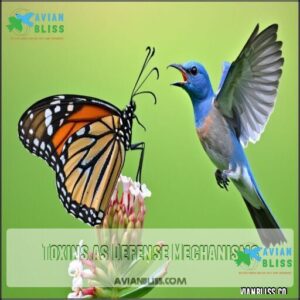This site is supported by our readers. We may earn a commission, at no cost to you, if you purchase through links.

Many birds, like warblers, robins, sparrows, and even hummingbirds, enjoy butterflies as part of their diet. However, not all butterflies are appetizing.
Species like monarchs and pipevine swallowtails pack toxins that make birds avoid them—kind of like nature’s way of saying "hands off."
Even so, some birds, such as orioles, have been seen carefully eating around the toxic parts. It’s a fascinating balance in the food chain, where every player has a role.
What’s more, this dynamic helps maintain biodiversity in your backyard or local park, and it’s all part of a delicate balance.
Table Of Contents
- Key Takeaways
- Birds That Eat Butterflies
- Butterfly Species That Birds Avoid
- Butterfly Gardens and Bird Feeders
- Butterfly Predators and Defense Mechanisms
- Monarch Butterflies and Predation
- Ecosystem Roles of Butterflies and Birds
- Birds and Butterfly Ecosystem Impact
- Frequently Asked Questions (FAQs)
- Can a bird eat a butterfly?
- What birds eat butterflies?
- What do butterflies eat?
- Do Songbirds eat butterflies?
- Why don’t birds eat butterflies?
- Do parrots eat butterflies?
- How often can a Bird Eat Butterflies?
- What type of birds eat butterflies?
- What is the predator of butterflies?
- Why do birds not eat monarch butterflies?
- Conclusion
Key Takeaways
- Birds like warblers, sparrows, and robins eat butterflies for protein intake, but they often avoid toxic species like monarchs.
- Monarchs and pipevine swallowtails use toxins and bright warning colors to deter birds, with some non-toxic species like viceroys using mimicry for protection.
- Some birds, like orioles, adapt by eating non-toxic parts of butterflies, showcasing nature’s balance and adaptability.
- Creating butterfly gardens with native plants and avoiding pesticides supports both butterflies and insect-eating birds, promoting biodiversity.
Birds That Eat Butterflies
You might be surprised to learn how many birds enjoy butterflies as a snack, regardless of their beauty or bright colors.
From warblers to sparrows and even hummingbirds, these avian hunters rely on butterflies for a quick protein boost.
Types of Birds That Eat Butterflies
Butterflies might seem delicate, but insectivorous birds have perfected the art of catching them. Each species brings its unique twist to the hunt, showcasing nature’s balance.
Insect-hunting birds turn butterfly catching into an art form, combining agility, precision, and nature’s perfect balance.
- Flycatchers, with their sharp beak adaptations, dart through the air and pluck butterflies mid-flight like experts catching frisbees.
- Orioles and Tanagers, vibrant and resourceful, include butterflies in their seasonal predation menu.
- Even Hummingbirds, best known for nectar sipping, mix things up by consuming butterfly eggs or larvae for extra protein.
- Flycatchers: Agile aerial hunters.
- Hummingbirds: Versatile diet includes butterfly larvae.
- Orioles: Opportunistic feeders targeting butterflies seasonally.
These birds, like the great crested flycatcher, play an important role in the ecosystem. These skilled butterfly predators help regulate populations, ensuring ecosystem harmony.
Warblers, Sparrows, Flycatchers, and Robins
Chasing insects mid-flight, warblers and flycatchers are masters of their craft.
These agile birds display incredible speed and precision, making butterflies a prime target in their hunting strategy.
Warbler hunting is especially impressive—they dart between trees, snatching prey with acrobatic moves.
Flycatchers, on the other hand, use a sit-and-wait approach, spotting butterflies before taking swift action.
Sparrows and robins focus on the ground, where butterfly larvae and caterpillars are abundant.
The sparrow diet often includes foraged insects, while robins balance between seeds and proteins.
This mix substantially impacts nature’s balance.
To further enhance the habitat, consider ways to attract more warblers.
Who knew birds eat butterflies with such skill and diverse techniques?
Bluebirds and Phoebes as Butterfly Eaters
Precision and skill define how bluebirds and phoebes catch butterflies. Imagine a bluebird perched high, scanning for movement like a focused sentry. With remarkable eyesight and swift flight, it dives swiftly, snatching its prey mid-air—a hallmark of the Bluebird Diet.
These birds rely heavily on insects during summer, making butterflies a key part of their meals. Phoebes employ their own tactics that could rival professional athletes. Known for their patience, they often perch like watchtower guards, waiting for the perfect moment.
Phoebe Hunting is all about timing, as they glide gracefully to grab flying insects like butterflies. Supplementing their diet can be achieved by purchasing insect-based food products.
- **Bluebirds thrive on insect-heavy summer diets.
- **Phoebes’ hunting pairs speed with precision.
- **Aerial Butterfly Capture demands sharp reflexes.
- **Their feeding methods impact butterfly populations.
- **Both species influence ecosystems by balancing insect numbers.
Bluebirds and phoebes showcase how birds eat butterflies with incredible agility and skill.
Nuthatches, Chickadees, Grosbeaks, and Hummingbirds as Butterfly Eaters
In the context of opportunistic eaters, nuthatches, chickadees, grosbeaks, and hummingbirds prove that birds eat butterflies with surprising skill.
The Nuthatch Diet includes acrobatic bark probing for hidden insect treats.
Chickadee Hunting peaks during nesting, with insects making up over half their meals.
With their crushing beaks, grosbeaks make quick work of butterfly wings during Grosbeak Consumption.
Hummingbirds, known for nectar feeding, catch small butterflies mid-flight for much-needed protein.
These insect-eating birds adapt effortlessly, blending diverse prey into their bird diet, with butterfly preference varying by species.
Nature’s web seamlessly connects predators and prey in fascinating ways.
Butterfly Species That Birds Avoid
You’d be surprised how many butterfly species birds avoid, thanks to their clever defense strategies.
Toxic compounds, bright warning colors, and mimicry make Monarchs, Pipevine Swallowtails, and others a less-than-tempting meal, utilizing mimicry as part of their defense.
Monarch, Luna Moth, Viceroy, and Pipevine Swallowtail
Not all butterflies are easy meals for birds.
Some species have clever tricks to avoid becoming lunch! Here are four fascinating examples:
- Monarch butterflies taste awful to birds thanks to toxic cardiac glycosides stored from milkweed.
- Viceroy butterflies resemble Monarchs so closely that birds avoid them too, even though they’re not toxic—a brilliant case of mimicry!
- Luna moths avoid predation by being nocturnal.
- Pipevine swallowtails pack a punch with aristolochic acids, creating a bitter taste that birds quickly remember and avoid.
These adaptations showcase how evolution shapes bird preferences and predator-prey interactions!
Toxic Properties of These Butterfly Species
In the context of butterflies that birds avoid, some species have mastered the art of chemical warfare.
Monarch butterflies are experts at this, storing cardiac glycosides (or cardenolides) from milkweed plants during their larval stage.
These toxins stick with them throughout their lives, making them a toxic snack.
Their bright orange-and-black wings, a classic example of aposematism, scream, “Not worth it!” to predators.
Pipevine Swallowtails take a similar approach, using aristolochic acids from host plants to deter hungry birds.
The outcome? Birds dealing with nausea or digestive issues quickly learn these aren’t appetizers they want.
Notably, some clever butterflies, like the Viceroy, rely on mimicry defense, copying the appearance of toxic species like Monarchs without carrying any toxins themselves.
Even as some birds eat butterflies, they often avoid the toxic ones or use detoxification mechanisms to handle small exposures.
Nature never stops surprising us!
Why Birds Avoid These Butterfly Species
Toxic butterflies, with their dazzling colors, aren’t just pretty—they’re sending a bold "stay away" message to predators.
Birds eat butterflies, but biting into a toxic species like a Monarch can make them regret it fast. One nibble of these butterfly toxins can cause severe nausea and unforgettable discomfort.
Why birds practice avoidance:
- Bright warning colors act like flashing neon signs screaming "DANGER!"
- Bitter, horrible taste forces birds to spit out their meal.
- Experience burns an aversion into the bird’s memory, preventing future mistakes.
- Chemical compounds, like cardiac glycosides in Monarchs, can upset or harm predators.
Even cunning mimicry defense allows harmless species to borrow this survival playbook!
Butterfly Gardens and Bird Feeders
You can create a vibrant backyard ecosystem with butterfly gardens and bird feeders working together.
By providing flowers for nectar and seeds for birds, you’ll attract a fascinating mix of pollinators and feathered visitors.
Enhancing Biodiversity With Butterfly Gardens
A butterfly garden isn’t just beautiful – it’s an ecological powerhouse that nurtures butterflies and birds alike.
By thoughtfully planning your garden design, you’ll create a sanctuary for wildlife while enjoying the magic of fluttering wings and birdsong.
Here’s a handy table to guide your habitat creation:
| Garden Element | Butterfly Benefit | Bird Benefit |
|---|---|---|
| Native Plants | Natural nectar and shelter | Attracts insects for food |
| Shallow Water | Drinking spots | Bathing stations |
| Shelter Areas | Safe hiding places | Nesting materials |
| Sunny Spots | Warmth for energy | Perfect hunting perches |
| No Pesticides | Caterpillar protection | Healthy food sources |
By using sustainable practices like avoiding pesticides and choosing native plants, you’ll foster balanced butterfly bird interactions.
It’s an easy way to support biodiversity while creating a gorgeous, inviting space.
Visual Interest and Harmonious Environment
A well-designed garden bridges beauty and balance, making it a haven for butterflies and birds.
By blending vibrant flora with thoughtful features, you can create a stunning yet harmonious retreat that supports both species while showcasing nature’s finest interactions.
Here’s how to master your habitat design for maximum visual balance and appeal:
- Use eye-catching blooms: Choose plants in red, yellow, and purple hues to attract butterflies while complementing your overall garden aesthetics.
- Diversify plant life: Mix tall, short, and gradually blooming plants—it’ll invite both hungry birds and fluttery butterflies year-round.
- Design safe zones: Separate predator zones (for bird feeding) from prey-friendly spots to encourage natural behaviors without disturbing butterfly havens.
- Structure your garden: Add birdhouses, butterfly puddling areas, or fun perches to foster bird-butterfly interactions while entertaining the eyes.
Consider adding pole-mounted feeders to attract a wider variety of bird species.
With these small steps, your wildlife sanctuary becomes a living masterpiece.
Butterfly Predators and Defense Mechanisms
You’d be surprised how many creatures want to snack on butterflies, including birds, reptiles, and even insects.
But don’t worry—these delicate creatures have clever tricks like toxins, bright colors, and mimicry to stay off the menu.
Birds, Reptiles, Mammals, and Insects as Predators
Nature’s food web is a battlefield brimming with predator competition.
Butterflies face various threats, each playing a unique role in the ecosystem.
Here’s a breakdown of common butterfly predators and their predator strategies:
- Birds eat butterflies mid-flight with precision.
- Reptilian predators, like snakes and lizards, prefer ambush tactics, striking unsuspecting butterflies resting on leaves.
- Mammal consumption comes from bats and mice that hunt during darker hours, taking advantage of reduced butterfly activity.
- Insect predators use clever tricks—mantises snatch butterflies mid-air, while spiders trap them in sticky webs.
These predator-prey relationships keep ecosystems balanced, even if it’s a tough world for butterflies!
Camouflage and Mimicry as Defense Mechanisms
Birds are clever predators, but butterflies have amazing tricks to stay safe.
Camouflage helps them vanish into their surroundings, like bark or leaves, making them nearly invisible. Some take it further with mimicry—pretending to be toxic species, like the Viceroy copying the Monarch, fooling birds into thinking they’re off-limits.
Bright, flashy colors scream, “Don’t eat me—I taste horrible!” These butterfly defense mechanisms rely on evolutionary advantages and predator deception, helping them outsmart hungry birds.
Birds also employ early threat detection to avoid their own predators. It’s a masterclass in behavioral adaptations and how nature guarantees survival through clever strategies.
Toxins as Defense Mechanisms
Hungry birds don’t have it easy—many butterflies pack a toxic punch to stay off the menu.
Many butterflies turn the tables on predators, using toxic tricks to say, "Not today, feathered foe!
Monarchs are famous for loading up on glycoside toxicity from milkweed, leaving any bird that dares to snack on them with a foul aftertaste and a vital lesson learned.
Birds’ avoidance of these butterflies showcases the power of a few clever tricks:
- Aposematism: Bright, flashy colors scream, “I’m too toxic to eat!”
- Mimicry defense: Harmless butterflies fool predators by mimicking toxic species.
- Palatability factors: Unappetizing toxins force birds to reconsider their food choices.
Some persistent birds attempt detoxification, but many quickly recognize butterfly toxins, proving these defense mechanisms guarantee survival in nature’s risky game.
Monarch Butterflies and Predation
You might think Monarch butterflies are safe from birds because of their toxins, but some birds have learned to eat them anyway.
By avoiding the worst parts or tolerating the toxins, these predators can turn a harmful meal into a useful snack.
Monarch Predators: Birds, Mice, and Other Animals
Despite their bright colors and toxic defense, monarch butterflies aren’t safe from predators.
Fascinatingly, certain birds, like black-backed orioles and black-headed grosbeaks, have adapted to chomping monarchs without harm, even munching through butterfly toxicity. These clever eaters sometimes target specific monarch parts, avoiding the most toxin-rich area.
Mouse predation is another story. Black-eared mice, for example, nibble on roosting monarchs, carefully sidestepping high-toxin spots. Their strategies are as precise as a chef trimming a meal.
Other predators include lizards, which see monarchs as quick snacks. When milkweed’s natural toxins fall short, many predators step in.
- Monarch-eating experts: Black-headed grosbeaks, orioles
- Mice strategy: Avoid toxin-heavy spots
- Lizards and others: Opportunistic hunters
Impact of Predation on Monarch Population
Monarch butterflies face an uphill battle with predators, even with their toxic milkweed defenses.
Some birds have adapted to tolerate these toxins, reducing the Monarch decline but intensifying the predator-prey relationship.
Adding to this is migration impact, where Monarchs are most vulnerable. Habitat loss further compounds the issue, leaving butterfly populations struggling for survival.
| Factor | Impact | Outcome |
|---|---|---|
| Milkweed Toxins | Partial bird protection | Limited predator deterrence |
| Bird Adaptation | Overcomes toxin resistance | Increased predation on Monarchs |
| Migration Challenges | Vulnerability during travel | High mortality in butterfly journeys |
Conservation efforts to restore milkweed and reduce habitat loss remain essential for Monarch survival amidst these ecological impacts.
Patterns of Predation on Monarchs
You’ve probably heard about monarch butterfly toxicity and how it discourages bird predation, but the story gets even more interesting.
Birds often target male monarch butterflies because they carry fewer milkweed toxins, making them less risky to eat. Over time, birds like blue jays develop bird learning behaviors, learning to avoid monarchs entirely after a bad experience.
Raccoons, for example, are opportunistic eaters of eggs, but also nestlings.
- Seasonal predation peaks during migration when monarchs are more exposed.
- Viceroys mimic monarchs, tricking birds into bird avoidance.
- Regional variations in food availability push birds to eat monarchs more often.
- Consumption rates depend on the butterfly’s toxin levels.
- Only a few bird species regularly brave monarch toxicity for a meal.
Ecosystem Roles of Butterflies and Birds
You’ll find that butterflies and birds each play key roles in supporting ecosystems, from pollination to regulating insect populations.
Their interactions, though sometimes predatory, help maintain balance and biodiversity in nature.
Producers and Consumers in The Ecosystem
In every ecosystem, birds eating butterflies isn’t just dinner—it’s nature’s way of maintaining balance.
Butterflies, as primary consumers, munch on plants and pass that energy upward through trophic levels.
This predator-prey relationship between insect-eating birds and butterflies helps maintain ecological pyramids.
Plus, these connections form dynamic food webs, keeping all roles in sync.
Birds act like guardians, ensuring no overpopulation while butterflies use clever defenses to survive.
Together, they sustain ecological balance beautifully.
Adaptations and Population Categorization
Nature’s predator-prey game between birds and butterflies is a lesson in survival and smarts.
Both species have incredible tricks up their sleeves to keep the balance just right:
- Monarchs cleverly store toxins from milkweed, leaving most birds with no appetite for a second bite.
- Blue jays use sharp beaks to skillfully remove toxic parts before feasting.
- Butterfly categorization reflects population dynamics—predation and seasons directly affect who thrives and who struggles.
- Bird adaptations like sharp vision and aerial agility let them target specific butterfly species with precision.
- Mimicry evolution grants some butterflies a disguised look to outsmart predators.
It’s survival mechanics—and nature’s evolutionary handshake—at its finest, showcasing a delicate balance of power and smarts in the natural world.
Food Chain and Interdependence
Birds and butterflies are like dance partners in the food chain, playing unique roles in ecosystem stability.
When birds munch on butterflies, they’re not just snacking—they’re regulating populations and driving evolutionary changes.
Let’s break it down:
- Energy Flow – Butterflies transform plant energy into sustenance for insectivores.
- Population Balance – Predation keeps butterfly numbers in check.
- Biodiversity Impact – Predator-prey relationships strengthen interconnected species.
- Adaptation Boost – Butterflies evolve defenses through ecosystem interactions.
Without this balance, ecosystems falter.
Birds and Butterfly Ecosystem Impact
You mightn’t realize it, but birds and butterflies keep ecosystems in check through a delicate balance of predation and survival.
When birds hunt butterflies, they control populations, which helps prevent overpopulation and supports plant pollination indirectly, maintaining a balance that is crucial for the ecosystem’s health, particularly for pollination.
Research Findings on Bird Species and Monarch Predation
You might think Monarchs are safe with their toxic milkweed diet, but a few birds prove otherwise! Research shows Black-backed Orioles and Black-headed Grosbeaks boldly snack on these vibrant butterflies, posing a serious predation threat.
For most birds, Monarch consumption ends after one bitter bite, thanks to toxins triggering unpleasant effects like vomiting. Yet, Orioles and Grosbeaks have adapted, tolerating these toxic chemicals better than others.
Studies reveal predation patterns where these species actively target Monarchs, especially during winter in Mexico. Still, bright orange wings are nature’s “Do Not Eat” sign, training most birds through tough lessons.
It’s a fascinating example of bird learning and predator-prey dynamics. Nature sure keeps things interesting!
Sex-Based Predation and Toxin Levels
Male butterflies face bigger risks from birds. Why? Female Monarchs pack more toxins, inherited from milkweed, making them tougher snacks. Male toxicity levels fall short, leading birds to prefer them, reinforcing the predator-prey relationship.
Here’s how it breaks down:
- Females retain stronger defense chemicals.
- Males sequester fewer toxins.
- Bird learning sharpens predator habits.
- Sexual dimorphism impacts butterfly survival.
Effects of Bird Predation on Butterfly Populations
A well-balanced world relies on bird-butterfly interactions.
Birds act as natural regulators, keeping butterfly numbers in check.
This predator-prey relationship maintains healthy ecosystems by preventing caterpillars from devouring plants completely.
Monarchs may seem invincible with their toxic defenses, but even they fall prey—particularly when migratory birds cross their paths.
Let’s break it down:
| Effect on Butterflies | Bird Factor |
|---|---|
| Population Regulation | Predators reduce excess. |
| Trophic Cascades | Maintains ecosystem flow. |
| Species Adaptation | Butterflies evolve defenses. |
| Conservation Strategies | Balance habitats for all. |
While birds help with population control, habitat loss and climate change play bigger roles in declines.
Protecting both species through smarter conservation strategies keeps the balance intact—and makes the world a bit more magical.
Frequently Asked Questions (FAQs)
Can a bird eat a butterfly?
Of course, a bird can eat a butterfly! For many species, they’re an easy snack packed with protein.
However, some butterflies, like Monarchs, are toxic, teaching birds to avoid them after one unpleasant meal.
What birds eat butterflies?
Imagine a buffet in the skies—birds like Blue Jays, Orioles, Warblers, and sparrows enjoy butterflies.
Predatory birds, including Flycatchers and Tanagers, seek them too, balancing nature’s scales while savoring their colorful, protein-rich prey.
What do butterflies eat?
Butterflies mostly drink nectar from flowers, but they also sip from mud puddles, rotting fruit, and animal droppings to get nutrients like salts and minerals.
It’s like their version of a salty snack!
Do Songbirds eat butterflies?
Songbirds, like Warblers and Sparrows, do eat butterflies, including their eggs and larvae.
They target smaller butterflies for protein but often avoid toxic species like Monarchs.
It’s nature’s way of balancing beauty with survival!
Why don’t birds eat butterflies?
Bright butterflies baffle birds.
Toxic tricks, like Monarchs’ glycosides, leave predators puzzled or queasy.
Birds prefer safer snacks, recalling past mistakes.
Vibrant colors and erratic flights work wonders, making butterflies look like nature’s edible escape artists, using toxic tricks to survive.
Do parrots eat butterflies?
Parrots occasionally eat butterflies, though it’s not their main diet.
They may snack on them for extra protein, especially in the wild.
It’s rare, but when they do, it’s more like an opportunistic treat!
How often can a Bird Eat Butterflies?
Imagine birds at a buffet—how often they eat butterflies depends on their size and diet.
Small birds munch one or two daily, while larger ones may snack infrequently.
It’s all about appetite and availability.
What type of birds eat butterflies?
Birds like Orioles, Blue Jays, Sparrows, Warblers, and Flycatchers love butterflies.
Some even hunt mid-air while others pluck resting ones off leaves.
Notably, clever birds avoid toxic butterflies like Monarchs after learning the hard way!
What is the predator of butterflies?
Butterflies face predators like birds, spiders, and lizards.
Birds such as Orioles, Blue Jays, and Warblers often target them. Spiders and lizards ambush butterflies, blending into their surroundings to catch them unaware.
Nature’s a battlefield!
Why do birds not eat monarch butterflies?
Don’t bite off more than you can chew—Monarch butterflies pack a toxic punch!
They store milkweed’s glycosides, making birds sick if eaten.
After one taste, birds learn to steer clear of these colorful flyers.
Conclusion
Butterfly battles and bird behavior show how nature balances biodiversity.
Yes, birds eat butterflies, but not all species are snacks. Monarchs and pipevine swallowtails, with their toxic traits, keep predators cautious.
Some clever birds, like orioles, nibble non-toxic parts, proving adaptability in the food chain.
Creating habitats—think butterfly gardens and feeders—boosts biodiversity and highlights these fascinating dynamics.
Next time you spot a butterfly or bird, you’re witnessing nature’s intricate ecosystem at work, which is brilliantly balanced.
- https://whateats.com/what-eats-butterflies
- https://www.birdsandblooms.com/birding/attracting-birds/insect-eating-birds/?srsltid=AfmBOopqw1O460K5107F6NfUsAPN8ChYNRr29ehSNi9ZOqjJdJiYym0N
- https://images.peabody.yale.edu/lepsoc/jls/1960s/1964/1964-18(3)165-Petetersen.pdf
- https://www.birdtipper.com/do-birds-eat-butterflies/
- https://www.gardenweb.com/discussions/1759138/do-birds-eat-butterflies














